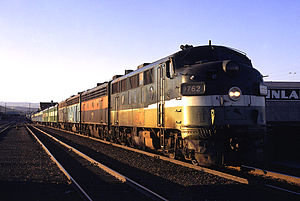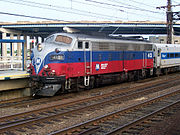EMD F3
This article has multiple issues. Please help improve it or discuss these issues on the talk page. (Learn how and when to remove these messages)
|
| EMD F3 | |||||||||||||||||||||||||||||||||||||||||||||
|---|---|---|---|---|---|---|---|---|---|---|---|---|---|---|---|---|---|---|---|---|---|---|---|---|---|---|---|---|---|---|---|---|---|---|---|---|---|---|---|---|---|---|---|---|---|
 BN #9762, ex-NP #6502, leading the North Coast Hiawatha into Yakima, Washington in August 1971. | |||||||||||||||||||||||||||||||||||||||||||||
| |||||||||||||||||||||||||||||||||||||||||||||
| |||||||||||||||||||||||||||||||||||||||||||||
| |||||||||||||||||||||||||||||||||||||||||||||
The EMD F3 is a 1,500-horsepower (1,100 kW) B-B freight- and passenger-hauling carbody diesel locomotive produced between July 1945 and February 1949 by General Motors’ Electro-Motive Division. Final assembly was at GM-EMD's La Grange, Illinois plant. A total of 1,106 cab-equipped lead A units and 694 cabless booster B units were built.
The F3 was the third model in GM-EMD's highly successful F-unit series of cab unit diesel locomotives, and it was the second most produced of the series. The F3 essentially differed from the EMD F2 in that it used the “new” D12 generator to produce more power and from the later EMD F7 in electrical equipment. Some late-model F3's had the same D27 traction motors, along with the heavier-duty electrical cables, used in the F7, and were referred to as model F5 by EMD's Engineering Department.
Design
[edit]The F3 used a 16-cylinder 567B series diesel engine developing 1,500 hp (1.1 MW) at 800 rpm. The 567 was designed specifically for railroad locomotives, a mechanically scavenged, or "blown" 2 stroke 45 degree V type with 567 cu in (9.29 L) displacement per cylinder, for a total of 9,072 cu in (148.66 L). A D.C. generator powered four traction motors, two on each Blomberg B truck.[1][2]
The carbodies of the A units varied over the production history of the F3 and are grouped by historians into four phases. Phase I is similar to the F2, distinguished by three portholes on the side and "chicken wire" grilles along the top edge of the carbody. Phase II reduced the number of portholes to two and included wire mesh between the portholes. Phase III eliminated that mesh; Phase IV eliminated the top wire mesh in favor a stainless steel grille.[3]
Eighteen F3s and one F7 were rebuilt for commuter rail service in 1978–1979. The most significant changes was the installation of a separate generator for head-end power. Visually, the side panels with portholes were replaced. The rebuilt locomotives were designated FP10.[4]
-
A Toledo, Peoria and Western Railway F2 (center) with Phase I body (three portholes)
-
Bangor and Aroostook Railroad F2 with Phase II body
-
Atchison, Topeka and Santa Fe Railway locomotive with Phase III body
-
Atchison, Topeka and Santa Fe Railway locomotives with Phase IV body
-
Metro-North Railroad FP10
History
[edit]The F3 was designed as a follow-up to the successful EMD FT locomotive. The primary changes were threefold: mechanical reorganization of the interior to permit faster construction, an improved prime mover developing 1,500 hp (1.1 MW) instead of 1,350 hp (1.01 MW), and a new main generator (the D12) to handle the increased power output.[5] After problems developed with the first set of demonstration locomotives, EMD introduced a modified design called the F2 using the generator (D4) from the FT. This limited power output to 1,350 hp (1.01 MW).[6] EMD built 104 F2s while it worked to eliminate the problems with the D12 generator.[7] Production of the F3 began in November 1946.[6]
Original owners
[edit]EMD built approximately 1,800 F3 locomotives: 1,106 A units and 694 B units. Forty-nine railroads purchased A units; of these, thirty-nine purchased B units. The three most significant buyers were the Union Pacific Railroad, Southern Railway, and Southern Pacific Railroad, which purchased 179, 178, and 160 locomotives, respectively. Other major buyers included the Pennsylvania Railroad, Chicago, Burlington and Quincy Railroad, and Atchison, Topeka and Santa Fe Railway.[5]
Preservation
[edit]Several F3s are preserved at tourist lines and museums, including:
Notes
[edit]- ^ Pinkepank (1973), pp. 13, 26, 90–101.
- ^ Ross (2003), pp. 261, 273.
- ^ Cook (2015b), pp. 54–55.
- ^ Solomon (2011), pp. 138–139.
- ^ a b Cook (2015a), p. 26.
- ^ a b Cook (2015a), p. 28.
- ^ Cook (2015a), p. 25.
- ^ "Locomotives". Alberta Railway Museum. Retrieved November 2, 2024.
- ^ "Locomotives". Danbury Railway Museum. Retrieved November 2, 2024.
- ^ "DL&W F3 Locomotive #663". Tri-State Railway Historical Society. Retrieved November 2, 2024.
- ^ "About Us". Anthracite Railroads Historical Society. Retrieved November 2, 2024.
References
[edit]- Cook, Preston (Spring 2015). "F Units, T to 9". Classic Trains. pp. 20–35. ISSN 1527-0718.
- Cook, Preston (Spring 2015). "Inside an F unit". Classic Trains. pp. 54–55. ISSN 1527-0718.
- Pinkepank, Jerry A. (1973). The Second Diesel Spotter's Guide. Milwaukee, Wisconsin: Kalmbach Publishing. ISBN 978-0-89024-026-7.
- Ross, David, ed. (2003). The Encyclopedia of Trains and Locomotives. New York: Barnes & Noble. ISBN 978-0-7607-9679-5.
- Solomon, Brian (2011). Electro-Motive E-Units and F-Units: The Illustrated History of North America's Favorite Locomotives. Minneapolis, Minnesota: Voyageur Press. ISBN 978-0-7603-4007-3.
Further reading
[edit]- Burlington Route Historical Society. EMD model F3. Burlington Route Historical Society - Roster. Retrieved November 22, 2021, from http://www.burlingtonroute.org/Qrailroad/roster/F3_diesel_locomotives.php.
- Dorin, Patrick C. (1972). Chicago and North Western Power. Burbank, California: Superior Publishing. pp. 119–121. ISBN 0-87564-715-4.
- Lamb, J. Parker (2007). Evolution of the American Diesel Locomotive. Railroads Past and Present. Bloomington, Indiana: Indiana University Press. ISBN 978-0-253-34863-0.
- Marre, Louis A. (1995). Diesel Locomotives: The First 50 Years: A Guide to Diesels Built Before 1972. Railroad Reference Series. Waukesha, Wisconsin: Kalmbach Publishing. ISBN 978-0-89024-258-2.
- Monon Railroad Historical-Technical Society, Inc. Monon diesel-electric roster. Monon Railroad Historical-Technical Society, Inc. Retrieved November 22, 2021, from https://monon.org/documents/MononDieselRoster.pdf.
- Rio Grande Modeling & Historical Society. DRGW F3 Roster. Rio Grande Modelling and Historical Society. Retrieved November 22, 2021, from https://www.rgmhs.org/data/diesels/f3.html Archived 2021-11-23 at the Wayback Machine.
- Russell, Larry G. "The F5" Extra 2200 South #96 pages 19–22, and 28.
- Schafer, Mike (1998). Vintage Diesel Locomotives. Enthusiast Color Series. Osceola, Wisconsin: MBI Publishing. ISBN 978-0-7603-0507-2.
- Solomon, Brian (2000). The American Diesel Locomotive. Osceola, Wisconsin: MBI Publishing Company. ISBN 978-0-7603-0666-6.
- Solomon, Brian (2005). EMD F-Unit Locomotives. North Branch, Minnesota: Specialty Press. ISBN 978-1-58007-192-5.
- Solomon, Brian (2006). EMD Locomotives. St. Paul, Minnesota: Voyageur Press. ISBN 978-0-7603-2396-0.
- Solomon, Brian (2010). Vintage Diesel Power. Minneapolis, Minnesota: MBI Publishing. ISBN 978-0-7603-3795-0.
- Solomon, Brian (2012). North American Locomotives: A Railroad-by-Railroad Photohistory. Minneapolis, Minnesota: Voyageur Press. ISBN 978-0-7603-4370-8.
- Wilson, Jeff (1999). F Units: The Diesels That Did It. Golden Years of Railroading. Waukesha, Wisconsin: Kalmbach Publishing. ISBN 978-0-89024-374-9.





